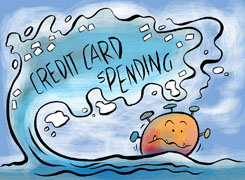Samraat Jadhav |2498 Answers |Ask -Follow
Stock Market Expert - Answered on May 07, 2024
He is a SEBI-registered investment and research analyst and has over 18 years of experience in managing high-end portfolios.
A management graduate from XLRI-Jamshedpur, Jadhav specialises in portfolio management, investment banking, financial planning, derivatives, equities and capital markets.... more

मैं 31 वर्षीय विवाहित व्यक्ति हूँ। मैं लगभग 10 लाख के भयानक कर्ज के जाल में फँसा हुआ हूँ। मैं किसी भी तरह और जल्द से जल्द इससे बाहर निकलना चाहता हूँ। कृपया मदद करें। मैं वर्तमान में 70 हजार के वेतन पर एक MNC में काम करता हूँ।
आप नीचे ऐसेही प्रश्न और उत्तर देखना पसंद कर सकते हैं
Ramalingam Kalirajan |10872 Answers |Ask -Follow
Mutual Funds, Financial Planning Expert - Answered on May 04, 2024
Ramalingam Kalirajan |10872 Answers |Ask -Follow
Mutual Funds, Financial Planning Expert - Answered on Nov 08, 2024
Ramalingam Kalirajan |10872 Answers |Ask -Follow
Mutual Funds, Financial Planning Expert - Answered on May 15, 2025
Samraat Jadhav |2498 Answers |Ask -Follow
Stock Market Expert - Answered on Jul 14, 2025
Naveenn Kummar |233 Answers |Ask -Follow
Financial Planner, MF, Insurance Expert - Answered on Sep 11, 2025
Nayagam P P |10852 Answers |Ask -Follow
Career Counsellor - Answered on Dec 07, 2025

शोध करियर संभावनाएँ: आईआईएससी, आईआईटी और उससे आगे: शोध-उन्मुख करियर के लिए, अमृता में एकीकृत एम.एससी भौतिकी कार्यक्रम एक असाधारण आधार प्रदान करता है। अमृता का पाठ्यक्रम विशेष रूप से गेट और यूजीसी-नेट परीक्षा के पाठ्यक्रम के अनुरूप है, और संस्थान प्रारंभिक शोध जुड़ाव पर जोर देता है। अमृता के संकाय स्कोपस-सूचीबद्ध पत्रिकाओं में सक्रिय रूप से शोध प्रकाशित करते हैं, पिछले पाँच वर्षों में अंतरराष्ट्रीय स्थानों पर 60 से अधिक प्रकाशनों के साथ, जो आपको सक्रिय शोध वातावरण से परिचित कराते हैं।
आईआईएससी जैसे प्रमुख संस्थानों में शोध करने के लिए, आप आमतौर पर पीएचडी मार्ग का अनुसरण करेंगे। आईआईएससी अपने एकीकृत पीएचडी कार्यक्रमों के माध्यम से एमएससी स्नातकों को स्वीकार करता है, और अमृता एमएससी के साथ, आप आवेदन करने के पात्र हैं। आपको संबंधित प्रवेश परीक्षाओं को उत्तीर्ण करना होगा, और आपके एकीकृत कार्यक्रम का शोध के मूल सिद्धांतों पर जोर मजबूत तैयारी प्रदान करता है। आपके एकीकृत एमएससी के अंतिम वर्ष को जानबूझकर कक्षा की प्रतिबद्धताओं से लगभग मुक्त रखा गया है, जिससे आईआईएससी, आईआईटी और राष्ट्रीय प्रयोगशालाओं जैसे संस्थानों में शोध परियोजनाओं में संलग्न होना संभव हो सके। अमृता के आंकड़ों के अनुसार, शैक्षणिक वर्ष 2019-20 के दौरान एमएससी भौतिकी के 80% से अधिक छात्रों को प्रतिष्ठित संस्थानों से इंटर्नशिप के प्रस्ताव मिले, जिससे सीधे तौर पर शोध करियर में बदलाव की सुविधा मिली।
प्लेसमेंट और प्रत्यक्ष रोजगार के अवसर: अमृता विश्वविद्यालय में कॉर्पोरेट और सरकारी क्षेत्र के साथ मजबूत संबंधों के साथ एक व्यापक प्लेसमेंट इकोसिस्टम है। अमृता इंटीग्रेटेड एम.एससी. प्रोग्राम (5-वर्षीय) के लिए एनआईआरएफ प्लेसमेंट डेटा के अनुसार, 2023-24 में औसत वेतन लगभग 57% प्लेसमेंट दर के साथ ₹7.2 लाख प्रति वर्ष था। हालाँकि, ये आँकड़े सामान्य प्लेसमेंट रुझानों को दर्शाते हैं; भौतिकी स्नातक अक्सर विशिष्ट तकनीकी भूमिकाओं में उच्च पैकेज प्राप्त करते हैं। कई स्नातक इंफोसिस (शुरुआती प्रस्तावों के साथ), गूगल और पेपाल जैसी सॉफ्टवेयर कंपनियों में शामिल होते हैं, जहाँ उनके मजबूत विश्लेषणात्मक और कम्प्यूटेशनल कौशल प्रवेश स्तर के पदों के लिए ₹8-15 लाख प्रति वर्ष तक के प्रतिस्पर्धी मुआवजे के पैकेज की मांग करते हैं।
अमृता में कॉर्पोरेट और औद्योगिक संबंध विभाग भाषाई दक्षता, डेटा व्याख्या, समूह चर्चा और साक्षात्कार तकनीकों को कवर करने वाला गहन तीन-सेमेस्टर जीवन कौशल प्रशिक्षण प्रदान करता है। यूपीएससी भूभौतिकीविद् परीक्षाओं में एमएससी भौतिकी या अनुप्रयुक्त भौतिकी को योग्यता डिग्रियों के रूप में स्पष्ट रूप से सूचीबद्ध किया गया है, जिससे आप भारतीय भूवैज्ञानिक सर्वेक्षण और केंद्रीय भूजल बोर्ड में ग्रुप ए पदों के लिए प्रतिस्पर्धा कर सकते हैं। भूभौतिकीविद् पदों के लिए आयु सीमा 32 वर्ष (आरक्षित श्रेणियों के लिए छूट के साथ) है, और परीक्षा में प्रारंभिक, मुख्य और साक्षात्कार चरण शामिल हैं।
BARC (भाभा परमाणु अनुसंधान केंद्र) सक्रिय रूप से वैज्ञानिक अधिकारियों और अनुसंधान अध्येताओं के रूप में एमएससी भौतिकी स्नातकों की भर्ती करता है। परमाणु विज्ञान, विकिरण सुरक्षा और परमाणु अनुसंधान में पदों के लिए भर्ती BARC ऑनलाइन परीक्षा या GATE स्कोर के माध्यम से होती है। BARC ग्रीष्मकालीन इंटर्नशिप कार्यक्रम उपलब्ध हैं, जो भविष्य के वैज्ञानिकों की भर्ती के अवसर के साथ ₹5,000-₹10,000 मासिक वजीफा प्रदान करते हैं।
DRDO (रक्षा अनुसंधान और विकास संगठन) रक्षा प्रौद्योगिकी, हथियार प्रणालियों और लेजर भौतिकी अनुसंधान से संबंधित भूमिकाओं के लिए CEPTAM परीक्षाओं या GATE स्कोर के माध्यम से एमएससी भौतिकी स्नातकों की भर्ती करता है। इसरो (भारतीय अंतरिक्ष अनुसंधान संगठन) नियमित रूप से मजबूत भौतिकी पृष्ठभूमि वाले उम्मीदवारों के लिए प्रतिस्पर्धी भर्ती के माध्यम से वैज्ञानिक/इंजीनियर पदों के लिए विज्ञापन देता है, जिसमें उपग्रह प्रौद्योगिकी और अंतरिक्ष विज्ञान अनुप्रयोगों में अवसर प्रदान किए जाते हैं।
अन्य महत्वपूर्ण नियोक्ताओं में भारतीय मौसम विज्ञान विभाग (IMD) शामिल है जो वैज्ञानिक अधिकारियों के रूप में भर्ती करता है, और NPCIL (भारतीय परमाणु ऊर्जा निगम लिमिटेड), जो वैज्ञानिकों के लिए ₹8-12 LPA से अधिक के प्रतिस्पर्धी मुआवजा पैकेज के साथ स्थिर सरकारी सेवा प्रदान करता है।
वैकल्पिक करियर पथ: UPSC, CDS, और AFCAT: UPSC सिविल सेवा (IFS - भारतीय वन सेवा): M.Sc भौतिकी स्नातक UPSC सिविल सेवा परीक्षाओं के लिए अर्हता प्राप्त करते हैं, वन सेवा विज्ञान-आधारित प्रशासनिक भूमिकाओं के अवसर प्रदान करती है जिनमें वरिष्ठ सरकारी पदों तक पहुँचने की संभावना होती है।
CDS/AFCAT (सशस्त्र बल): जहाँ AFCAT मौसम विज्ञान शाखाओं के लिए विशेष रूप से "60% न्यूनतम अंकों के साथ गणित और भौतिकी के साथ B.Sc" की आवश्यकता होती है, वहीं तकनीकी शाखाओं (वैमानिकी इंजीनियरिंग और ग्राउंड ड्यूटी तकनीकी भूमिकाएँ) के लिए इंजीनियरिंग/प्रौद्योगिकी में स्नातक/एकीकृत स्नातकोत्तर की आवश्यकता होती है। एम.एससी. भौतिकी तकनीकी योग्यताओं के साथ अच्छी तरह से मेल खाती है, हालाँकि सीधे अधिकारी पद के लिए आपको इंजीनियरिंग पृष्ठभूमि की आवश्यकता होगी। हालाँकि, यदि आप वैकल्पिक रक्षा चैनलों के माध्यम से आवेदन करते हैं, तो आप विशेष तकनीकी साक्षात्कारों के लिए पात्र बने रहते हैं।
यूजीसी-नेट परीक्षा: यह मार्ग भारत भर के केंद्रीय विश्वविद्यालयों और कॉलेजों में सहायक प्रोफेसर के पदों तक पहुँच प्रदान करता है। नेट-योग्य उम्मीदवारों को पीएचडी के साथ 2-वर्षीय जेआरएफ पदों के लिए ₹31,000/माह की छात्रवृत्ति मिलती है, जो सरकारी संस्थानों में ₹41,000/माह के सहायक प्रोफेसर वेतन में परिवर्तित हो जाती है। यह मार्ग अनुसंधान के अवसरों के साथ दीर्घकालिक शैक्षणिक कैरियर सुरक्षा प्रदान करता है।
निजी क्षेत्र की तकनीकी भूमिकाएँ
एमएससी भौतिकी स्नातकों को डेटा विज्ञान, सॉफ्टवेयर इंजीनियरिंग और तकनीकी परामर्श में तेजी से महत्व दिया जा रहा है। कंपनियाँ सॉफ्टवेयर विकास के लिए भौतिकी स्नातकों की सक्रिय रूप से भर्ती करती हैं, जहाँ मजबूत समस्या-समाधान और तार्किक तर्क ₹10-20 लाख प्रति वर्ष के प्रतिस्पर्धी पैकेज में तब्दील हो जाते हैं। क्वांटम कंप्यूटिंग विकास, वित्तीय मॉडलिंग और वैज्ञानिक कंप्यूटिंग सहित विशिष्ट डोमेन प्रीमियम मुआवजा प्रदान करते हैं। वैज्ञानिक कंप्यूटिंग में आपका माइनर आपको कम्प्यूटेशनल विशेषज्ञता की आवश्यकता वाली प्रौद्योगिकी कंपनियों के लिए विशेष रूप से आकर्षक बनाता है।
अंतर्राष्ट्रीय अवसर और विदेश में उच्च अध्ययन
अमृता से एमएससी करने पर अंतर्राष्ट्रीय संस्थानों में पीएचडी कार्यक्रमों में प्रवेश मिलता है। जर्मन विश्वविद्यालय ट्यूशन-मुक्त या कम शुल्क वाले एमएससी भौतिकी कार्यक्रम (2 वर्ष) प्रदान करते हैं, जिनमें डीएएडी जैसी छात्रवृत्तियाँ 850 यूरो से अधिक मासिक वजीफा प्रदान करती हैं। अमेरिकी विश्वविद्यालय एमएससी स्नातकों को पूर्ण वित्त पोषण (ट्यूशन कवरेज + वजीफा) के साथ सीधे पीएचडी पदों के लिए स्वीकार करते हैं। इन मार्गों के लिए जीआरई स्कोर और शोध रुचियों को स्पष्ट करने वाला एक ठोस उद्देश्य कथन आवश्यक है। मैक्स प्लैंक इंस्टीट्यूट (जर्मनी) और कैलटेक समर रिसर्च प्रोग्राम (यूएसए) के साथ अनुसंधान सहयोग के अवसर मौजूद हैं, दोनों ही भारतीय एमएससी छात्रों का स्वागत करते हैं।
तुरंत विकसित करने योग्य आवश्यक कौशल और प्रमाणपत्र: प्रोग्रामिंग भाषाएँ: पायथन सीखना तुरंत शुरू करें—यह अनुसंधान और उद्योग में सार्वभौमिक रूप से उपयोग किया जाता है। डेटा विश्लेषण, वैज्ञानिक कंप्यूटिंग लाइब्रेरी (न्यूमपी, साइपाई, पांडा) और मशीन लर्निंग के मूल सिद्धांतों के लिए साप्ताहिक 2-3 घंटे समर्पित करें। MATLAB भौतिकी अनुप्रयोगों, विशेष रूप से संख्यात्मक सिमुलेशन और डेटा विज़ुअलाइज़ेशन के लिए समान रूप से महत्वपूर्ण है। अपने पहले वर्ष में ही MATLAB प्रमाणन पाठ्यक्रम पूरा करने का लक्ष्य रखें।
शोध उपकरण: Git/संस्करण नियंत्रण, वैज्ञानिक दस्तावेज़ीकरण के लिए LaTeX और डेटा विश्लेषण ढाँचे सीखें। शोध पत्र प्रकाशित करने और परियोजनाओं पर सहयोग करने के लिए ये कौशल अनिवार्य हैं।
प्राप्त करने योग्य प्रमाणन: (1) MATLAB प्रमाणन (DIYguru या MathWorks के आधिकारिक पाठ्यक्रम) (2) डेटा विज्ञान के लिए पायथन (कोर्सेरा जैसे प्लेटफ़ॉर्म से पूर्ण प्रमाणपत्र कार्यक्रम) (3) मशीन लर्निंग फंडामेंटल्स (तकनीकी बहुमुखी प्रतिभा का विस्तार करने के लिए) और (4) वैज्ञानिक संचार और तकनीकी लेखन (विभागीय कार्यशालाओं के माध्यम से विकसित)
रणनीतिक इंटर्नशिप योजना: अमृता के शोध संबंधों का व्यवस्थित रूप से लाभ उठाएँ। अपने तीसरे वर्ष में, BARC समर इंटर्नशिप, IISER इंटर्नशिप, TIFR समर फ़ेलोशिप और IIT इंटर्नशिप कार्यक्रमों (जैसे IIT कानपुर SURGE) के लिए आवेदन करें। ये आपको अग्रणी शोध से परिचित कराते हैं और साथ ही भविष्य में पीएचडी या वैज्ञानिक भर्ती के लिए संपर्क स्थापित करते हैं। बहुमुखी प्रतिभा विकसित करने के लिए विभिन्न विशेषज्ञताओं में 2-3 शोध इंटर्नशिप का लक्ष्य रखें।
संक्षेप में, अमृता से प्राप्त आपकी इंटीग्रेटेड एम.एससी. भौतिकी की डिग्री आपको IISc/IITs में प्रतिस्पर्धी शोध करियर, BARC/DRDO/ISRO में प्रतिष्ठित सरकारी वैज्ञानिक पदों और अंतर्राष्ट्रीय पीएचडी अवसरों के लिए असाधारण रूप से उपयुक्त बनाती है। इस प्रोग्राम का वैज्ञानिक कंप्यूटिंग पर ज़ोर आपको नौकरी के बाज़ार में अलग पहचान दिलाता है। तात्कालिक प्राथमिकताएँ: (1) पहले दो वर्षों में पायथन और MATLAB में महारत हासिल करें; (2) वर्ष 2-3 से शुरू होने वाले शोध परियोजनाओं में संलग्न हों; (3) प्रमुख शोध संस्थानों में इंटर्नशिप का लक्ष्य रखें; (4) भर्ती में अधिकतम लचीलेपन के लिए अपनी डिग्री पूरी करते हुए GATE की तैयारी करें; (5) दीर्घकालिक शैक्षणिक स्थिरता के लिए UGC-NET पर विचार करें। आपके करियर की दिशा अंततः मज़बूत शोध बुनियादी सिद्धांतों को विकसित करने, विशेषज्ञता के क्षेत्रों में निरंतर उत्कृष्टता प्रदर्शित करने और इंटर्नशिप व शोध के अवसरों का रणनीतिक रूप से चयन करने पर निर्भर करेगी। अनुशासित कौशल विकास के साथ कठोर अमृता प्रोग्राम आपको विभिन्न क्षेत्रों में असाधारण करियर सफलता के लिए तैयार करता है। ऊपर बताए गए विभिन्न विकल्पों में से अपने लिए सबसे उपयुक्त विकल्प चुनें। आपके समृद्ध भविष्य के लिए शुभकामनाएँ!
'करियर | पैसा | स्वास्थ्य | रिश्ते' पर अधिक जानने के लिए RediffGURUS को फॉलो करें।
Nayagam P P |10852 Answers |Ask -Follow
Career Counsellor - Answered on Dec 07, 2025
Radheshyam Zanwar |6736 Answers |Ask -Follow
MHT-CET, IIT-JEE, NEET-UG Expert - Answered on Dec 06, 2025

शुभकामनाएँ।
अगर आपको यह उत्तर मिले तो मुझे फ़ॉलो करें।
राधेश्याम
Dr Nagarajan J S K |2576 Answers |Ask -Follow
NEET, Medical, Pharmacy Careers - Answered on Dec 06, 2025
Mihir Tanna |1090 Answers |Ask -Follow
Tax Expert - Answered on Dec 06, 2025
Ramalingam Kalirajan |10872 Answers |Ask -Follow
Mutual Funds, Financial Planning Expert - Answered on Dec 06, 2025
Radheshyam Zanwar |6736 Answers |Ask -Follow
MHT-CET, IIT-JEE, NEET-UG Expert - Answered on Dec 06, 2025
Radheshyam Zanwar |6736 Answers |Ask -Follow
MHT-CET, IIT-JEE, NEET-UG Expert - Answered on Dec 06, 2025
Radheshyam Zanwar |6736 Answers |Ask -Follow
MHT-CET, IIT-JEE, NEET-UG Expert - Answered on Dec 06, 2025
Dr Dipankar Dutta |1837 Answers |Ask -Follow
Tech Careers and Skill Development Expert - Answered on Dec 05, 2025


























